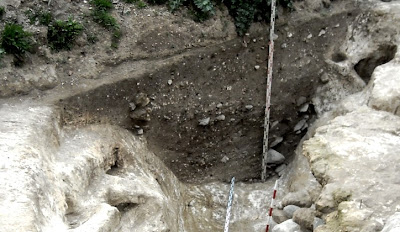Chronology: Chalcolithic (with a previous occupation of Early Neolithic)
Bibliographic references: Cardoso, 2010.
The hill where the site is, with the Tagus River valley behind (after Cardoso, 2010)
Located on a hilltop that dominates the lower Tagus river valley, this site presents a walled enclosure dated from plain/final Chalcolithic. The chronology is deduced by the presence of the locally characteristic decorated pottery (“Folha de Acácia” type), bell beaker vessels and copper and gold artefacts (Palmela point, gold decorated plate and object related to metallurgical work).
The stone wall is considered to represent a unique built phase, defining an ellipsoidal enclosure (44m x 80m), with an entrance in the South side (facing the Tagus River). It was built with local basalt rocks, but also with limestone, brought uphill from the bottom of the mount. Those limestone blocks were especially used in the wall faces (the middle was filled in basaltic rocks). The white of the limestone walls would have generated a strong visual contrast in the top of the dark volcanic hill.
Plan of the enclosure (after Cardoso, 2010)
That strategy of visibility is stressed by the author in the context of a territorial and circulation control between the Tagus valley and the hinterland of Lisbon Peninsula (as would represent the Zambujal walled enclosure in the other side of the Peninsula – the sea side). A settlement-fortress of a regional strategy of occupation, defence and control.
Nearby is the Verdelha dos Ruivos cave, used for Bell Beaker funerary depositions and related with the enclosure as its possible necropolis. The same hypothesis is developed for some local megalithic tombs (as Casal do Penedo ).
That strategy of visibility is stressed by the author in the context of a territorial and circulation control between the Tagus valley and the hinterland of Lisbon Peninsula (as would represent the Zambujal walled enclosure in the other side of the Peninsula – the sea side). A settlement-fortress of a regional strategy of occupation, defence and control.
Nearby is the Verdelha dos Ruivos cave, used for Bell Beaker funerary depositions and related with the enclosure as its possible necropolis. The same hypothesis is developed for some local megalithic tombs (as Casal do Penedo ).



